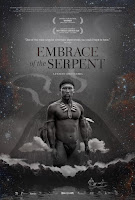Movie Review: Embrace of the Serpent (Spanish)
 |
| Embrace of the Serpent |
But the Amazon is also much more than that, bearing testimonies to the dark days of unchecked colonialism, the irreparable damage the "white" invaders from the East caused to the ecosystem and the aboriginal culture, by not just despoiling the nature they worshipped, but by also depriving the indigenous people of their very access to life and eventually marginalising them. Director Ciro Guerro beautifully explores all these and a lot more — like those observations about materialism, culture clash and its corruption at the hands of Christian missionaries — by interweaving two voyages along the river, one in 1909 and the second, three decades later in 1940, undertaken by a German ethnographer and an American botanist (the movie is inspired by the diaries written by the two scientists during their field work in the Amazon), both of whom embark in search of a sacred (fictional) healing plant yakruna, accompanied by a reluctant but worldly wise Amazonian shaman, Karamakate, the last known survivor of his tribe.

Comments
Post a Comment